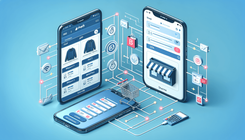How to convert Shopify Store to a Mobile App using API
Hi all. My name is Mary and I'm a Shopify developer. I'm planning to develop a mobile application using the storefront API. However, I had only developed websites before and had no experience with mobile applications.
I found several apps that help you convert your website into a mobile app, but they don't give you access to the code. In the future, I will need to connect some custom features to this application, so I want to find out how I can make the application myself.
Reasons and Causes of the Problem
Many developers face the challenge of transitioning from website development to mobile app development, especially when dealing with APIs and backend connections. When aiming to convert a Shopify store into a mobile app using the API, the lack of resources or guides tailored to this specific process can be a major obstacle. Without the right knowledge and support, developers may struggle to bridge the gap between web and mobile technologies.
Guide to Solving the Problem
To successfully convert your Shopify store into a mobile app using the API, follow these steps:
-
Understanding the Shopify Storefront API: Familiarize yourself with the functionalities and endpoints offered by the Shopify Storefront API. This will be crucial for retrieving store data and syncing with your mobile app.
-
Setting Up a Development Environment: Create a development environment where you can test and integrate your mobile app with the Shopify store. Utilize tools like Postman for API testing and debugging.
-
Building the Mobile App: Choose a mobile app development framework that suits your skills and project requirements. Whether it's React Native, Flutter, or native development, ensure that you can leverage the Shopify API within the app.
-
Connecting to the Shopify API: Implement the necessary authentication and authorization mechanisms to securely connect your mobile app to the Shopify store. Use API keys and tokens to access store data.
-
Syncing Data: Develop functionalities within the mobile app to sync orders, users, products, and other relevant information with the Shopify store. Ensure real-time updates and data consistency.
-
Testing and Debugging: Thoroughly test the integration between the mobile app and the Shopify store. Address any errors or issues that may arise during data synchronization.
-
Deployment and Maintenance: Deploy your mobile app to app stores and continue to maintain and update it as needed. Monitor API changes from Shopify to ensure ongoing compatibility.
Questions and Answers
Q: Can I use third-party services to convert my Shopify store into a mobile app?
A: While there are third-party services available for this purpose, they may limit your ability to customize and extend the mobile app in the future. For greater control and flexibility, building the app yourself using the Shopify API is recommended.
Q: What challenges may arise when connecting a Shopify store to a mobile app?
A: Challenges such as authentication issues, data synchronization delays, and handling different device platforms can be encountered. By following best practices and seeking support from the Shopify developer community, you can overcome these challenges.
Q: Is it possible to create a seamless user experience between the Shopify store and the mobile app?
A: Yes, by designing the app interface to align with the Shopify store's branding and functionality, you can ensure a consistent and intuitive user experience across both platforms.
By following these steps and guidelines, you can successfully convert your Shopify store to a mobile app using the API. Embrace the learning curve and leverage the resources available to enhance your development skills.




